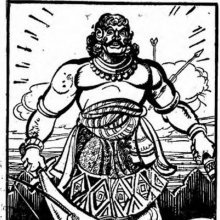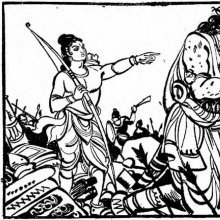Battle-field, Battlefield: 3 definitions
Introduction:
Battle-field means something in Buddhism, Pali, Hinduism, Sanskrit, the history of ancient India. If you want to know the exact meaning, history, etymology or English translation of this term then check out the descriptions on this page. Add your comment or reference to a book if you want to contribute to this summary article.
Images (photo gallery)
In Hinduism
Shilpashastra (iconography)
Source: Shodhganga: Elements of Art and Architecture in the Trtiyakhanda of the Visnudharmottarapurana (shilpa)The Battle-field follows specific guidelines of ancient Indian Painting (citra), according to the Viṣṇudharmottarapurāṇa, an ancient Sanskrit text which (being encyclopedic in nature) deals with a variety of cultural topics such as arts, architecture, music, grammar and astronomy.—In the context of identification of some particular places through picture, the Viṣṇudharmottarapurāṇa gives some instructions. According to this book, the picture of battle field should have caturaṅgabala i.e., a complete section of army consisting of elephants, chariots, cavalry and infantry. Moreover, the ground of the battle field should be filled with scattered dead bodies smeared with blood. In the Veṇīsaṃhāra, a fierce description of a battle field is found where the field is filled with dead bodies, human flashes, blood etc.

Shilpashastra (शिल्पशास्त्र, śilpaśāstra) represents the ancient Indian science (shastra) of creative arts (shilpa) such as sculpture, iconography and painting. Closely related to Vastushastra (architecture), they often share the same literature.
In Buddhism
Mahayana (major branch of Buddhism)
Source: Brill: Śaivism and the Tantric Traditions (mahayana)The Battlefield is mentioned in the Laghusaṃvaratantra, where it is claimed that:—One who enters the battlefield after reciting a certain mantra one thousand times towards the enemy cannot be hurt by weapons and obtains an indestructible vajra-body.

Mahayana (महायान, mahāyāna) is a major branch of Buddhism focusing on the path of a Bodhisattva (spiritual aspirants/ enlightened beings). Extant literature is vast and primarely composed in the Sanskrit language. There are many sūtras of which some of the earliest are the various Prajñāpāramitā sūtras.
India history and geography
Source: Singhi Jain Series: Ratnaprabha-suri’s Kuvalayamala-katha (history)Battle-fields were commonly depicted on the Saṃsāracakra paintings (representing scenes of human life), in ancient India, as mentioned in the Kathās (narrative poems) such as Uddyotanasūri in his 8th-century Kuvalayamālā (a Prakrit Campū, similar to Kāvya poetry).—Page 185.21 f.: Here follows a description of a printed scroll illustrating the Jaina conception of saṃsāracakra. [...] The saṃsāra-cakra illustrated the three worlds of hell, human world and the world of gods. [For example:] A recluse sitting on a palankeen and invited by the king; a soldier fighting with weapons on the battle-field.

The history of India traces the identification of countries, villages, towns and other regions of India, as well as mythology, zoology, royal dynasties, rulers, tribes, local festivities and traditions and regional languages. Ancient India enjoyed religious freedom and encourages the path of Dharma, a concept common to Buddhism, Hinduism, and Jainism.
See also (Relevant definitions)
Partial matches: Field.
Full-text (+350): Yuddhabhumi, Ranaranga, Rangabhumi, Ayodhana, Pradhanangana, Samaroddesha, Dhvajahrita, Sangamavacara, Rana, Ahavabhima, Yuddhamandala, Kurukshetra, Mogavarige, Kalambar, Kalambugu, Ranarangadhira, Nipatya, Samarangana, Samarbhumi, Ranabhumi.
Relevant text
Search found 143 books and stories containing Battle-field, Battlefield; (plurals include: fields, Battlefields). You can also click to the full overview containing English textual excerpts. Below are direct links for the most relevant articles:
Jnaneshwari (Bhavartha Dipika) (by Ramchandra Keshav Bhagwat)
Verse 1.47 < [Chapter 1 - Arjuna’s Dolour]
Verse 2.2 < [Chapter 2 - Samkhya-Yoga]
Verse 18.60 < [Chapter 18 - Moksha-sannyasa-yoga]
Nitiprakasika (Critical Analysis) (by S. Anusha)
Weapons and War in Nīti works < [Chapter 1]
War Planning < [Chapter 4]
Bhishma Charitra (by Kartik Pandya)
Canto 15 - Description of Mahābhārata war
Canto 14 - Description of Bhīṣma’s Bed of Arrows
The Shiva Purana (by J. L. Shastri)
Chapter 37 - Śaṅkhacūḍa fights with the full contingent of his army < [Section 2.5 - Rudra-saṃhitā (5): Yuddha-khaṇḍa]
Chapter 7 - Śiva manifests himself as a column of fire in the battlefield < [Section 1 - Vidyeśvara-saṃhitā]
Chapter 48 - The manifestation of Sarasvatī < [Section 5 - Umā-Saṃhitā]
Puranic encyclopaedia (by Vettam Mani)
The Padma Purana (by N.A. Deshpande)
Chapter 45 - Śrī Rāma Appears on the Battlefield < [Section 5 - Pātāla-Khaṇḍa (Section on the Nether World)]
Chapter 42 - Vīramaṇi Is Defeated < [Section 5 - Pātāla-Khaṇḍa (Section on the Nether World)]
Chapter 102 - Jalandhara Plays a Trick < [Section 6 - Uttara-Khaṇḍa (Concluding Section)]
Related products



